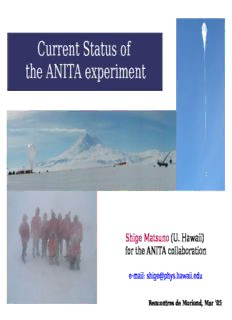
Current Status of the ANITA experiment PDF
Preview Current Status of the ANITA experiment
Current Status of the ANITA experiment Shige Matsuno (U. Hawaii) for the ANITA collaboration e-mail: [email protected] Rencontres de Moriond, Mar '05 ANITA collaboration (ANtarctic Impulsive Transient Antenna) Bartol: J. Clem, P. Evenson, D. Seckel ● UC Irvine: S. Barwick, L. Gerhardt, D. Goldsein, K. Kuehn, J. Nam, ● A. Silvestri UCLA: A. Connolly, D. Saltsberg, D. Williams ● Cornell: D. Besson ● U. Hawaii: C. Hebert, P. Gorham, J. Learned, J. Link, S. Matsuno, ● R. Milincic, P. Miocinovic, G. Verner JPL: K. Liewer, C. Naudet ● U. Minnesota: M. DuVernois, E. Lusczek ● NASA: D. Gregory ● Ohio State: J. Beatty, R. Nichol, K. Palladino ● Penn State: D Cowen ● Washington U., St. Louis: R. Binns, M. Isreal, M. Olevitch ● ANITA: aim and concept Aiming for a radio detection of GZK neutrinos in Antarctica. EM showers in dielectric generate coherent radio Cerenkov emission ⇒ Askaryan effect. Antarctic Ice Sheet (f < 1 GHz, T< −20˚ C) ~Lossless RF transmission • Minimal scattering • Largest homogenous RF transmissive solid mass in the World • Standard model GZK flux < 1 / km2 day 2 str. int. probability ~0.2%/km need a few years even for an 1 km3 detector to observe one. Askaryan Confirmation: SLAC T444 (2000) D.Saltzberg et al., Phys Rev Lett 86, 2802 (2001) also in LANL eprint: hepex/0011001 • Use 3.6 tons of silica sand, bremsstrahlung photons to avoid any charge entering target no transition radiation • Monitor all backgrounds carefully but signals were much stronger! • Shower profile observed by radio (~2GHz) 100% polarized Simulated shower curve In proper plane 2GHz data Sub-ns pulse, E ~ 200 V/m! p-p Reflection from side wall • Measured pulse field strengths follow shower profile very closely Charge excess also closely correlated to shower profile (EGS simulation) • fi • Polarization completely consistent with Cerenkov can track particle source Field intensity vs shower energy and radio frequency as predicted • ⇒ Cerenkov radio emmision Askaryan had predicted was confirmed! ANITA Payload 40 horn antennas (H and V • polarities) view > 2 sr with 60o overlapping beam width Intensity gradiometry, • interferometry, polarimetry used to determine pulse direction & thus original neutrino track orientation Angular resolution: • 0.5o for elevation and 1.5o for azimuth (for radio pulse), ~2o and 3~5o (for neutrino) weight ~1,600 kg, • total power ~1.0 kW Antarctica long duration balloon flight ANITA to be launched in Dec. 2006 for a ● circumpolar LD flight Power source (the Sun) is always up ● Nominal latitude of 78o S (ranging 73o~83o S) ● and 35km altitude – ~1500m average ice depth under the track ~4km deep! ~1500m avg. Neutrino Limits and Potential Future Sensitivity GLUE limits & ● e – ~120 hours livetime RICE ● – 3500 hours live time FORTE ● – N. Letinen et. al. PhysRevD64 ('04) 013008 – 3days satellite data over Greenland ice sheet ANITA ● – Sensitivity based on 2 (total 45 days) independent MC. – assuming three 15 days filghts Record breaking CREAM flight in 2004-5 season Circled South pole • 3 times. 42 days flight broke • the previous record prev. record = – 32 days set by Tiger flight in 2001-2 season ANITA recent activities Detector developement ● – testing and characterizing antenna in anechoic chambers in UH – finalizing gondola design details – developing a special high speed/density, low power circuitry capable of >1 GSamples/sec digitization and multi frequency triggering ● multiple event buffering to reduce dead time and ensure detection of ● possible "double bang" events 80 input channels (plus trigger, hk., etc.) in one 20 slots cPCI crate ● Detailed MC simulations ● – reveiw redio generation processes – include details on the ice surface (firn layer, sastrugi) ANITA-lite balloon flight ● – piggy back to Tiger flight over Antarctice in 2003-4 season – measured radio noise in a real balloon flight situation
Description: